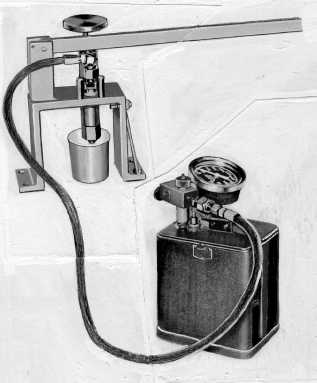NOZZLE OPERATION. - The pressurized fuel from the injection pump enters the top of the nozzle body and flows through a passage in the body and nozzle spring retainer. An annular groove in the top face of the nozzle valve body tills with fuel, and two passages in the nozzle valve body direct fuel around the nozzle valve. When the fuel in the pressure chamber reaches a predetermined pressure, the spring force (adjusted by shims) is overcome and injection occurs. Atomized fuel sprays from the orifice holes in the nozzle tip as the nozzle valve is opened inward by pressurized fuel. When injection ends, spring pressure snaps the valve in its seat. During each injection, a small quantity of high pressured fuel passes between the nozzle valve stem and the nozzle valve body to lubricate and to cool the nozzle valve. A manifold that connects to all of the nozzles returns this fuel to the tank.
NOZZLE TROUBLESHOOTING. - You can check the condition of a nozzle before it is disassembled by using the field test (Kiene). Remove the nozzle from the engine, and using the test pump shown in figure 5-27, check for nozzle spray angle and pattern. There are four orifices in the nozzle tip, and the spray angle should be uniform from all four. Also, check the spray valve opining pressure. A pressure reading that is more than 50 psi below the specified opening pressure of

Figure 5-27.-Test pump.
the valve indicates a need to adjust the pressure by adding shims. Next, test the leakage past the seat and stem. If this leakage is excessive due to wear, install a new nozzle valve.
Proceed with nozzle disassembly only after you have performed these and other tests prescribed in the test manual. While testing, record the results of the tests for each nozzle. They can help you determine the nature and extent of necessary repairs.
NOZZLE DISASSEMBLY/REASSEMBLY. - Before you disassemble the nozzle, clean the external area with cleaning fluid or clean diesel fuel oil, using a brush with long, soft bristles. Keep the disassembled nozzles separated to prevent mixing the various components. During inspection, refer to the test results which are used as a guide to determine the extent of reconditioning necessary.
After you have disassembled the nozzle, make sure each disassembled nozzle has been placed in a separate pan containing a cleaning solvent or clean diesel fuel oil. Soak the tips in a good carbon removal compound for the length of time prescribed by the manufacturer.
NOTE
As a word of caution, remember NOT to mix the tips together. Each tip must be reassembled with its own group parts.
Be careful when you clean the spray holes of the nozzle tip so that you do not enlarge or damage them. Use a magnifying glass during your inspection for signs of scratches, corrosion, or erosion on the spring retainer, the nozzle body holder, and the valve body face. Also, check the stem and the body of the valve, making sure they do not bind. Reassemble the nozzle in the manner prescribed and specified by the manufacturer's maintenance and repair manual. Before you install the nozzle in the engine, retest it for spray angle and pattern, valve opening pressure, and leakage past the seat and stem. When test results are good, install the nozzle in the engine.
GENERAL MOTORS FUEL INJECTION SYSTEM
The General Motors fuel injection system includes fuel injectors, fuel pipes, fuel manifolds, fuel pump, fuel strainer, fuel filter, and fuel lines connecting the fuel tank. The operation of this system depends on the
Continue Reading